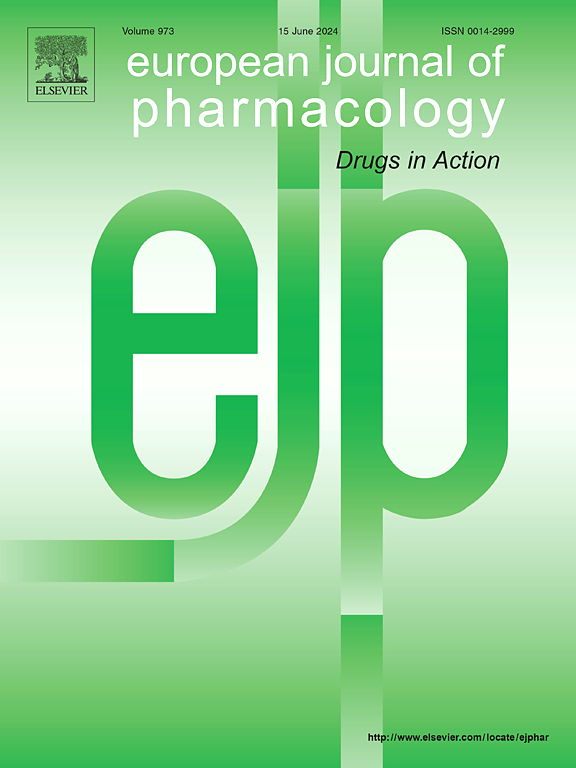Novel mechanisms of metformin-induced vasorelaxation of mesenteric arterioles via endothelium-dependent hyperpolarization to treat murine colitis
IF 4.7
3区 医学
Q1 PHARMACOLOGY & PHARMACY
引用次数: 0
Abstract
Research purpose
Metformin, an FDA-approved medication for type 2 diabetes mellitus (T2DM), has been previously reported to have anti-colitis effects via anti-inflammatory, antioxidant, and gut microbiota modulation. However, the precise mechanisms of metformin-induced vasorelaxation in intestinal resistance vessels in health and ulcerative colitis (UC), remain largely unknown.
Materials and methods
Mulvany-style wire myograph was used to determine metformin-induced vasorelaxation of human submucosal arterioles and mesenteric arterioles from wild-type C57BL/6 mice and transient receptor potential vanilloid 4 knockout mice (TRPV4 KO mice). Ca2+ imaging and patch clamp were applied in human umbilical vein endothelial cells (HUVEC). DSS-induced mouse UC model was used to examine the role of metformin-induced vasorelaxation in its anti-colitis effects.
Results
Metformin-induced vasorelaxation of human and mouse mesenteric arterioles through endothelium-dependent hyperpolarization (EDH) predominantly. Metformin induced endoplasmic reticulum (ER)/Ca2+ release via PLC/IP3/IP3R pathway in HUVEC. Metformin also promoted Ca2+ influx and membrane currents via store-operated Ca2+ entry (SOCE) and TRPV4 channels. Metformin/EDH-mediated vasorelaxation almost remained intact in colitis while acetylcholine (ACh)/EDH-mediated vasorelaxation was almost impaired totally. Importantly, metformin/EDH-mediated vasorelaxation could rescue the impaired ACh/EDH-mediated vasorelaxation and ameliorate the destructive colitis mucosae.
Conclusions
Metformin/EDH-mediated vasorelaxation protects intestinal mucosae against colitis by rescuing the impaired ACh-induced vasorelaxation to recover mucosal hemoperfusion. We reveal an innovative action mode and underlying mechanisms of metformin on microvascular activities in health and colitis. Our data strongly suggest that metformin could be repurposed as a safe and effective medication to prevent/treat colitis, especially as a choice of drug for patients suffering from T2DM and UC.
二甲双胍诱导肠系膜小动脉血管舒张通过内皮依赖性超极化治疗小鼠结肠炎的新机制。
研究目的:二甲双胍是fda批准的治疗2型糖尿病(T2DM)的药物,此前有报道称其通过抗炎、抗氧化和调节肠道微生物群具有抗结肠炎的作用。然而,在健康和溃疡性结肠炎(UC)中,二甲双胍诱导的肠道抵抗血管松弛的确切机制在很大程度上仍然未知。材料和方法:采用mulvany型钢丝肌图检测二甲双胍诱导的人粘膜下小动脉和肠系膜小动脉血管舒张情况,这些小动脉分别来自野生型C57BL/6小鼠和瞬时受体电位香草样蛋白4敲除小鼠(TRPV4 KO小鼠)。钙离子成像和膜片钳技术应用于人脐静脉内皮细胞(HUVEC)。采用dss诱导的小鼠UC模型,研究二甲双胍诱导的血管舒张在其抗结肠炎中的作用。结果:二甲双胍主要通过内皮依赖性超极化(EDH)诱导人和小鼠肠系膜小动脉血管舒张。二甲双胍通过PLC/IP3/IP3R途径诱导HUVEC内质网(ER)/Ca2+释放。二甲双胍还通过储存操作的Ca2+进入(SOCE)和TRPV4通道促进Ca2+内流和膜电流。结肠炎中二甲双胍/ edh介导的血管松弛几乎保持完整,而乙酰胆碱(ACh)/ edh介导的血管松弛几乎完全受损。重要的是,二甲双胍/ edh介导的血管松弛可以挽救受损的ACh/ edh介导的血管松弛,并改善破坏性结肠炎粘膜。结论:二甲双胍/ edh介导的血管舒张通过挽救受损的ach诱导的血管舒张恢复粘膜血液灌流来保护肠黏膜免受结肠炎的侵袭。我们揭示了二甲双胍对健康和结肠炎微血管活动的创新作用模式和潜在机制。我们的数据强烈表明,二甲双胍可以作为一种安全有效的预防/治疗结肠炎的药物,特别是作为T2DM和UC患者的药物选择。
本文章由计算机程序翻译,如有差异,请以英文原文为准。
求助全文
约1分钟内获得全文
求助全文
来源期刊
CiteScore
9.00
自引率
0.00%
发文量
572
审稿时长
34 days
期刊介绍:
The European Journal of Pharmacology publishes research papers covering all aspects of experimental pharmacology with focus on the mechanism of action of structurally identified compounds affecting biological systems.
The scope includes:
Behavioural pharmacology
Neuropharmacology and analgesia
Cardiovascular pharmacology
Pulmonary, gastrointestinal and urogenital pharmacology
Endocrine pharmacology
Immunopharmacology and inflammation
Molecular and cellular pharmacology
Regenerative pharmacology
Biologicals and biotherapeutics
Translational pharmacology
Nutriceutical pharmacology.

 求助内容:
求助内容: 应助结果提醒方式:
应助结果提醒方式:


